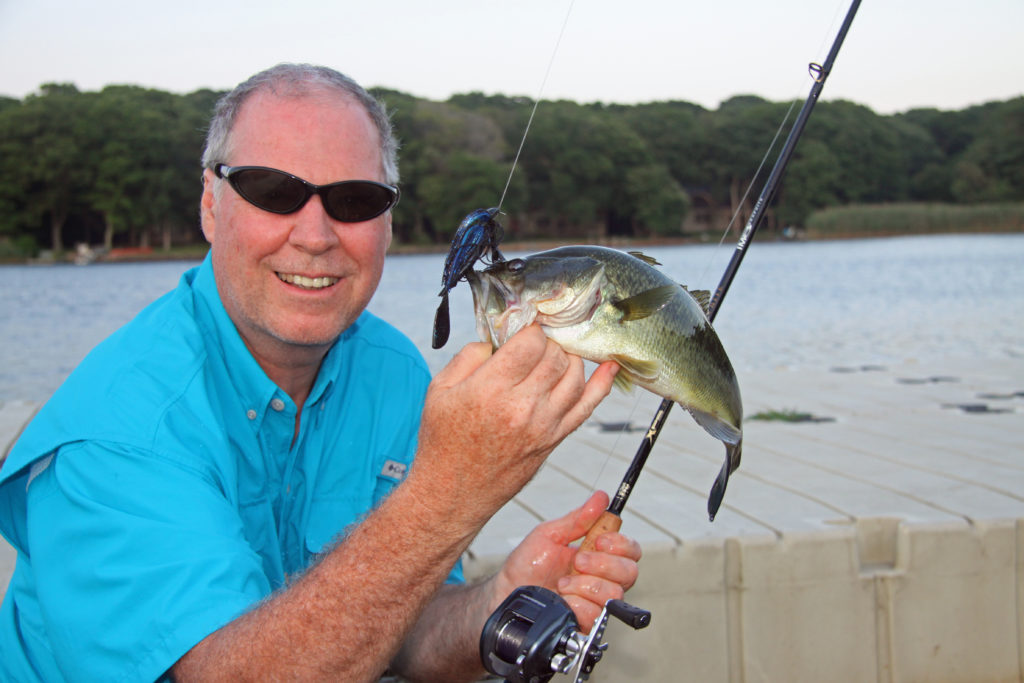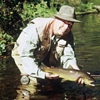BANG SOMETHING FOR BIGMOUTHS

Slam casting a big pig & jig against the dock in the background produced this chunky largemouth for the author. Photo by Ryan Schlichter.
It’s amazing how some August sunshine and even a marginal heat wave can slow local bass fishing to a crawl. Come late summer, most veteran bigmouth fans are glued to the dawn and dusk routine and a few have probably shifted to fishing on the midnight shift. While these anglers are indeed working the most productive time slots for connecting with summer lunkers, it doesn’t mean you have to go fishless the rest of the day. The bass may be sluggish and buried deep in weeds and tangles – but they are a captive audience. Sometimes you’ve just got to go out and wake ’em up. A fun and challenging way to do this is by banging stuff and slam casting. Both methods will work right now even on heavily pressured rivers, lakes and ponds.
HIT THE STICKS
No matter where they hide, bigmouths – especially trophy fish – gravitate toward wooden structure. That makes shore-side docks and standing posts or stumps obvious choices for bass hunters. But you can bet most wooden bass havens see enough pressure that the fish around them are highly educated and quite cautious. To wake up these fish, try banging your lures off any lumber or time-worn tree trunk you spot.
Rather than simply work the perimeter of a backyard deck or boat dock with a quiet plastic worm, for example, skip a large spinnerbait under the platform and out the other side before retrieving so that the lure actually bangs off posts as it both enters and exits the shadows. On longer or wider docks, toss your offering immediately adjacent to an outer edge and then tick each support as you bring the lure home. Repeat on the other side before probing directly underneath the planks. The same retrieves work with jig & pigs or even crank baits when docks extend over several feet of deep water.
Most anglers work the edges of docks, few make serious efforts to get their offerings as far underneath as possible. If necessary, get down close to the water and hand-toss your lure. You’ll be amazed at how far back a side-arm sling can carry your presentation.
BUMP THE STUMPS
On deeper waters summer sulkers may move out into eight to 20 feet of water or more. If the shallows fail to produce, use your electronics to search for submerged logs, stumps and boulders. Bass in deep water may hold at any depth, but if you can find structure on the bottom predators will likely be nearby. Try slow-rolling a large white or chartreuse spinnerbait, or dragging a large, white or pumpkinseed grub, over any prominent bottom piece you find.
In this case, the idea is to bump or bang the structure, then slide the spinnerbait or grub up and over, lifting it two or three feet before allowing it to settle on a slack line. If you find a submerged area of gravel or rip-rap on the bottom, or a prominent ledge, try ripping a large crank bait to dig deep, bouncing the lure’s lip time and again off the bottom. As long as the weeds will allow, keep contacting the bottom or structure, producing little clinks and clanks as your bring your lure home.
BANG THE PADS

Protruding branches reveal an opportunity to bang a weedless frog or brush a big plastic worm against some prime wood. Don’t pass this up. Photo by Tom Schlichter.

Areas with rocky bottoms are ideal for banging with deep diving plugs or tube lures. Bronzebacks love this approach, too. OutdoorTom.com photo.
On lakes sporting heavy surface vegetation, banging a jig & pig atop a weed matt or lily pad can be deadly. Simply drop a three-eight- to five-eight-ounce black, green or blue jig on top of a thick lily pad or stable weed matt and bounce it several times at rod’s length. Don’t allow the lure to penetrate the weeds and enter the strike zone at first. Instead, bang it repeatedly in place on the surface, pause for two or three seconds, then drag it s-l-o-w-l-y over the side for a free fall presentation.
You’ll need at least 14-pound test bait-casting gear to pull off this trick without too many break-offs. Be sure your drag is set fairly tight because any fish that gains a few feet after the hook is set is likely to bury itself in the stems long enough to leverage free before you can reach it.
SLAM CASTING
One of my favorite presentations for drawing reaction strikes from big bass is to slam a weedless frog against a retaining wall or bulkhead. Cast as hard as you can so the lure “splats” against a solid edge and drops lifelessly into the water. Allow the frog to sit motionless for 10 to 20 seconds, then give it a slight twitch or two. Pause again, then retrieve.
With this presentation, the strike can come at any time, but most often the water explodes as you begin the retrieve. The idea is to make your frog appear to be stunned, then awakening, then trying to escape. The build-up in anticipation can cause bass to really slam an offering as it moves out from the hardened edge. You can also try this with large, soft plastic creature baits or even a jig and pig if the water is deep and not too weedy. Slam that lure right up against a wall and let it drop lifeless to the bottom. Wait at least ten seconds before bringing it back to life.
Whether opting for the floating or the sinking approach, be sure to sharpen your hooks from time to time when using this technique. Done correctly, it will eventually dull the points.
By Tom Schlichter
Use the LIKE button below to get notifications about new articles in your Facebook news feed!



